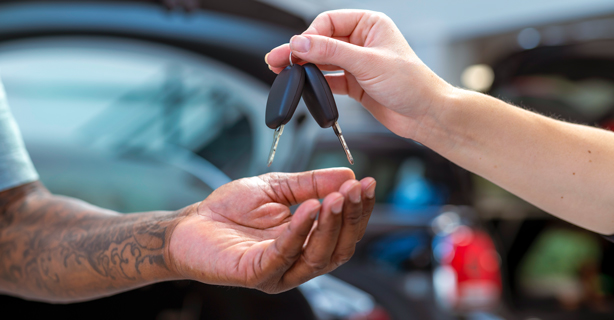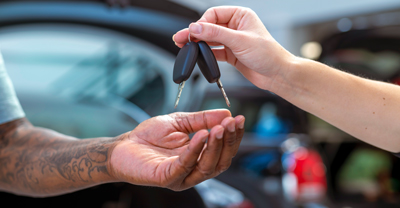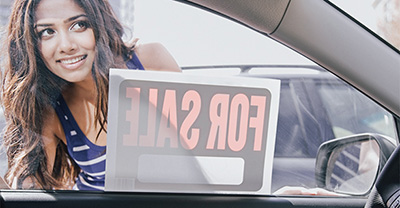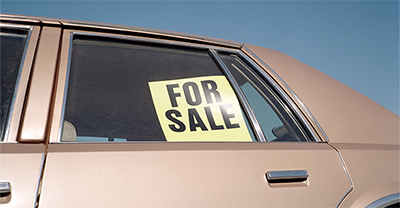How to buy a car from a private seller


0 min. read
Buying a used car from a private seller can be more complicated than buying from a dealership. But with some strategic research—and a little patience—you could end up finding the car of your dreams at a great value. Explore Dairyland’s cheap car insurance options to find the coverage that fits your lifestyle and budget.
Is buying a car from a private seller worth it?
It certainly can be—especially if you’re able to patiently shop around. You could potentially save hundreds or even thousands of dollars on a similar vehicle you’d find at a dealership.
That said, bypassing dealerships and online retailers in favor of private sellers can open you up to some risks. With this guide, we can help you mitigate them.

Request a free Dairyland® auto insurance quote.
Buying from a private party vs. a car dealership
Even with the growing popularity of online retailers like Carvana, the two most common methods of buying used vehicles remain private parties and dealerships. Here are some of the pros and cons of buying from a private seller:
What are the advantages of purchasing from a private seller?
The biggest reason people choose private sellers over dealerships is the opportunity to save money. If you’re shopping on a tight budget, you may be able to find older, more inexpensive cars from private sellers. Plus, many sellers are willing to negotiate more than dealerships—especially if they need the money quickly.
You may have a wider range of local options—especially if you live in a rural area where car dealerships, especially certified dealerships, are few and far between.
If you’ve built a relationship with a trusted mechanic or auto shop, you’ll probably be able to have them perform a pre-purchase inspection on the vehicle.
What are the disadvantages to purchasing a vehicle from a private seller?
There are no lemon laws for private-party car purchases. Once you and the seller complete the sale, you don’t have much recourse if you discover major issues with the car.
Relatedly, you could end up getting scammed by a private seller—or someone posing as a private seller. Some sellers will intentionally hide information or outright lie about the vehicle’s history in order to make the sale. And sometimes, the “seller” doesn’t even have a vehicle for sale—they’re just attempting to gather as much of a buyer’s personal information as they can.
Financing can be difficult, since most private sellers require buyers to pay in full at the time of purchase. Private-party auto loans are a good option if you don’t have the cash on-hand, but keep in mind that not all banks or credit unions offer these types of loans. And those that do often charge high interest rates and include more restrictive terms to balance out the increased risk associated with private-party purchases.
Steps to buying a car from a private party
Let’s walk through the process of purchasing a vehicle from a private seller. We know the circumstances that lead you to looking for a new car are unique to you, so don’t worry if the order of these steps don’t match your experience.
And remember, your safety is more important than any vehicle. If at any point you feel unsafe or that something doesn’t feel right, you can walk away.
Set a budget
Decide how much you’re comfortable spending on a used car. If you’re able to pay in cash without taking out a private-party auto loan, it can help you save money in the long term, since you won’t need to pay interest on loan payments.
Just keep in mind that there are often downsides to buying older, cheap cars—namely, the increased likelihood of significant maintenance and repair expenses.
Research used cars
Once you establish a price range, start looking for cars in your area. You have plenty of options online—including Craigslist, eBay, and Facebook Marketplace—along with the classifieds section of your local newspaper or buyer’s guide.
If a vehicle catches your eye:
Determine its value using Kelly Blue Book—this can help you decide whether the asking price seems suspiciously high or low given the information in the listing.
Contact the seller and ask questions about the vehicle, including:
Has the vehicle been in any accidents?
Has the vehicle ever undergone significant repairs?
Where has the seller brought it for repairs and maintenance?
Can the seller provide service records?
Why is the seller selling the vehicle?
Does the seller still owe money on the vehicle?
Ask for the VIN and look it up on websites like Carfax, which provide detailed reports on the vehicle’s history. If the seller refuses to provide the VIN, that’s a red flag. Similarly, if the seller’s answers to the above questions don’t match the vehicle’s history report, consider walking away.
Schedule a test drive
Work with the seller to schedule a test drive. Bring a friend or family member—ideally one who’s knowledgeable about cars—and meet with the seller in a public place, rather than your residence or theirs.

Get a free car insurance quote today.
Have a mechanic inspect the car
If the test drive goes well and you’re interested in continuing with the purchase, ask if you can have a professional mechanic inspect the vehicle. Request this step even if they’ve already had their own mechanic perform an inspection.
If seller says no, that’s another red flag—consider walking away from the sale.
Negotiate the sale price
Let’s say the test drive went well, your mechanic gives the all-clear, and you’re ready to buy the car. It’s time to negotiate on the final price. Remember, you have the leverage here—if the seller isn’t willing to work with you on a price you’re comfortable with, you can leave, and they’re back to square one in attempting to sell their vehicle.
That said, don’t overplay your hand, and don’t start with a potentially insulting counteroffer to the initial asking price. Provide the Kelly Blue Book information, your mechanic’s inspection report, comparable vehicle prices in the area, your feedback from the test drive, and any other research. The final price should end up as a compromise.
Complete the sale
Paying the seller can be as simple as handing them cash and documenting the receipt with a bill of sale. But it typically involves more steps than that—especially if you take out a loan or if the seller still owes money on the vehicle.
If you get a loan, your lender may write you a check that you forward to the seller, or they could pay the seller directly.
If the seller still owes money on the vehicle, your lender and the seller’s lender will likely want to set up a direct transfer, along with handling the title transfer. Additionally, if you’re taking out a loan on the vehicle, you’ll need to give the title to your lender.
What paperwork do I need to buy a car from a private seller?
Vehicle title: The seller will sign over the title to you as the new owner.
Bill of sale: This document—which indicates the title transfer, payment total, and both the buyer’s and seller’s signatures—makes the sale official.
Odometer disclosure statement: While not all states require this statement, it’s best to get it regardless.
Lien release information: This is only applicable if the seller has a lien on the vehicle.
We recommend meeting with the seller at your local Department of Motor Vehicles (DMV) office to complete the sale, to help ensure you don’t overlook any crucial elements of the sale.
Who pays sales tax when buying a car from a private party?
The buyer pays sales tax. Car tax rates vary by state—in some states it can exceed 8%, while other states don’t even require auto taxes. Make sure to incorporate taxes into your budget for the new car.
The general information in this blog is for informational or entertainment purposes only. View our blog disclaimer.










